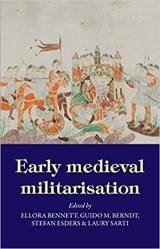 Название: Early medieval militarisation
Название: Early medieval militarisationАвтор: Ellora Bennett, Guido M. Berndt
Издательство: Manchester University Press
Год: 2021
Страниц: 384
Язык: английский
Формат: pdf, epub
Размер: 10.2 MB
The societies of ancient Europe underwent a continual process of militarisation, and this would come to be a defining characteristic of the early Middle Ages. The process was neither linear nor mono-causal, but it affected society as a whole, encompassing features like the lack of demarcation between the military and civil spheres of the population, the significance attributed to weapons beyond their military function and the wide recognition of martial values. Early medieval militarisation assembles twenty studies that use both written and archaeological evidence to explore the phenomenon of militarisation and its impact on the development of the societies of early medieval Europe. The interdisciplinary investigations break new ground and will be essential reading for scholars and students of related fields, as well as non-specialists with an interest in early medieval history.
Europe at the turn from Antiquity to the Middle Ages underwent a gradual evolution that may be characterised as militarisation. Depending on the geographic situation, historic background and military organisation, this process progressed at different rates and to different degrees. In north-eastern Gaul, for example, Romans and non-Romans lived for centuries in close contact both east and west of the Roman frontier. While the empire expanded, its frontiers were increasingly fortified. Armies were recruited from the population both inside and outside of the Roman territory, while those without Roman civic rights became part of the auxiliaries (foederati, laeti) and received such rights at the end of their service. Thus, the provinces of Gaul and Germany created large recruiting pools for the Roman army. While other provinces paid the recruitment tax in gold as a substitute, it was the Gallic provinces that furnished ‘bodies’. Despite laws forbidding the marriage of soldiers, many among those based in the border regions established families. These families lived in nearby canabae or vici, which soon became also the homes of farmers, artisans and tradesmen. The border that has attracted most scholarly attention is the north-western Rhine–Danube frontier which was home to a large number of military camps, among which places such as the castra Bonnensia (Bonn) or Vindobona (Vienna) grew into impressive settlements. From the later fourth century, these communities began to bury rather than cremate their dead and to furnish graves with weapons, one among the most impressive cemeteries being Krefeld-Gellep (between modern Duisburg and Düsseldorf). In contrast to the more central regions of the Roman Empire, this border population lived in close proximity to the potential threat of military violence and the military itself, a living condition that had only become the norm for Gaul's more central regions since the end of the pax Romana and the breakdown of the Roman limes in 406/7.
Early medieval militarisation applies modern approaches to structural history and the history of mentalities. It offers a wide-ranging alternative to conventional military histories and will be of interest to students and scholars of related fields.
Скачать Early medieval militarisation